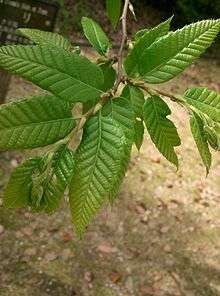Castanea crenata
Castanea crenata, known as Korean chestnut,[1] Korean castanea,[2] and Japanese chestnut,[3] is a species of chestnut originally native to Japan and South Korea. It is a small to medium-sized deciduous tree growing to 10–15 m tall. The leaves are similar to those of the sweet chestnut, though usually a little smaller, 8–19 cm long and 3–5 cm broad. The flowers of both sexes are borne in 7–20 cm long, upright catkins, the male flowers in the upper part and female flowers in the lower part. They appear in summer, and by autumn, the female flowers develop into spiny cupules containing 3–7 brownish nuts that are shed during October.
| Castanea crenata | |
|---|---|
 | |
| Scientific classification | |
| Kingdom: | Plantae |
| Clade: | Tracheophytes |
| Clade: | Angiosperms |
| Clade: | Eudicots |
| Clade: | Rosids |
| Order: | Fagales |
| Family: | Fagaceae |
| Genus: | Castanea |
| Species: | C. crenata |
| Binomial name | |
| Castanea crenata | |
Cultivation and uses
It is an important tree in Japan for its heavy production of sweet, edible nuts. A number of cultivars have been selected for large nut size. It is also widely cultivated in eastern China and Taiwan.
It is resistant to chestnut blight, and is of importance in North America in the development of disease-resistant hybrids with the highly susceptible American chestnut.
Examples of European × Japanese Hybrid Cultivars[4] are:
- 'Colossal'
- ‘Bouche de Betizac’
- ‘Precoce Migoule’
- ‘Labor Day’
Gallery
 Chestnut fruit
Chestnut fruit Peeled chestnuts
Peeled chestnuts Male flower
Male flower

.jpg) Shell opened naturally on the ground
Shell opened naturally on the ground
 Trees
Trees
References
- Falk, Ben (2003). The Resilient Farm and Homestead: An Innovative Permaculture and Whole Systems Design Approach. White River Junction, VT: Chelsea Green Publishing. p. 199. ISBN 9781603584449.
Varieties of chestnuts that can be grown in zone 4, Northeastern United States are as follows:
Crenata dentata (American Chestnut)
Castanea dentata × mollissima (American/central Asian cross)
Castanea mollissima (Chinese chestnut)*
Castanea seguinii × mollissima (dwarf hybrid of two Asian species)
Castanea crenata (Korean chestnut)
Castanea pumila hybrida (single-trunked selection of the chinquapin)
Castanea pumila (multiple-stemmed chinkapin)
Castanea sativa × mollissima (central Asian/Chinese cross) - English Names for Korean Native Plants (PDF). Pocheon: Korea National Arboretum. 2015. p. 401. ISBN 978-89-97450-98-5. Archived from the original (PDF) on 25 May 2017. Retrieved 22 December 2016 – via Korea Forest Service.
- "BSBI List 2007". Botanical Society of Britain and Ireland. Archived from the original (xls) on 2015-01-25. Retrieved 2014-10-17.
- Cultivars for Michigan Archived 2013-05-25 at the Wayback Machine Retrieved 2015-6
| Wikimedia Commons has media related to Castanea crenata. |